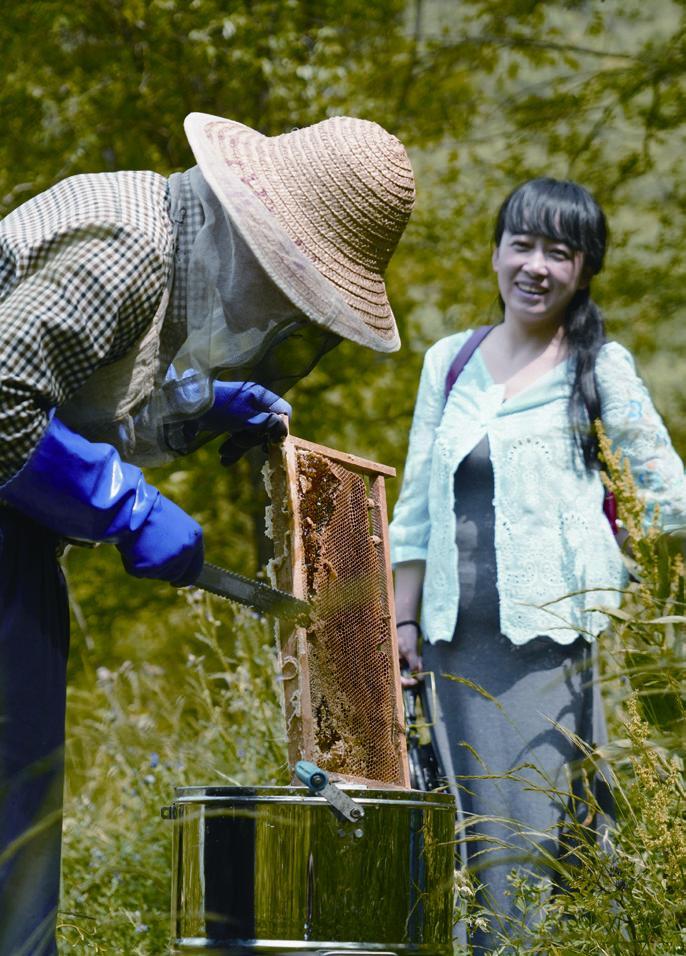GREEN REVOLUTION
2019-09-10ByWenQing
By Wen Qing
Liu Jin, a well-known actor lauded for playing the late Chinese Premier Zhou Enlai in many films and TV series, travels all over China to shoot for his different roles. Yanan, a former revolutionary base of the Communist Party of China (CPC) in Shaanxi Province in the northwest, is one of his regular destinations. He went to the city on the Loess Plateau at least 10 times before 2006 and his impression was of a dry place crisscrossed by bare ravines and gul- lies and frequently blanketed by ferocious sandstorms.
But when he went there again last year after a long gap, he couldnt believe his eyes. Yanan was scarcely the same city of his old memories. The once bare mountains were covered with green, turning the brown and yellow into a verdant landscape. For children born there after 2000, their hometown has been green as long as they can remember.
Behind the amazing change is two decades of a dogged large-scale afforestation drive. Since 1999, Yanan took the lead in implementing a national reforestation project popularly known as “grain for green,”a conservation initiative to reduce soil erosion and improve the degraded ecosystem in the Loess Plateau and other regions. Overexploited fields where grain was grown were allowed to lie fallow and then converted into forests. Today, Yanans vegetation coverage has almost doubled, from 46 percent in 2000 to 81.3 percent in 2017.



A historical necessity
“People avoided wearing white shirts in the 1990s as they would get dirty easily due to the frequent sandstorms,” Tang Kuncai, a Yanan resident in his 50s, said.
At that time, Yanans rugged mountains were bald, with almost no trees growing there. On windy days, the air scattered sand and dust over the city and people outside could barely open their eyes. When it rained, there were torrential downpours washing away the soil. Every year, over 200 million tons of sediments ended up in the Yellow River, contributing to nearly one sixth of the rivers overall average sedimentation. The soil loss and the plateaus inability to retain water resources aggravated its aridity.
According to historical records, Yanan was covered with forests and grass in the Han Dynasty (206 B.C.-A.D. 220). However, due to intense cultivation as well as wars, this green paradise gradually turned into a barren land.
Yanan was long in the border area with nomadic regimes. During the rule of various dynasties, the central government usually mobilized large numbers of people from other places to safeguard the frontier. With the increasing population, most areas were cleared to plant grains and the process of aridification began.
In the following centuries, Yanan remained stuck in the vicious cycle of “the more land they cultivated, the more barren the land was, and the poorer the people were.” U.S. journalist Edgar Snow wrote in his seminal 1937 book Red Star Over China, “A peasant could own as much as 100 mu of land and yet be a poor man.” The mu was an old Chinese land area measurement, equaling 667 square meters.
Yanan became headquarters of the CPC after the end of the Long March in 1935, attracting swarms of people from across the country to the small city. International observers like Snow also arrived. The CPC reached a cooperation agreement with the Kuomintang during the War of Resistance Against Japanese Aggression, but the Kuomintang often disrupted the united front.
“Facing an economic blockade by Kuomintang troops with limited outside resources accessible, the CPC had no choice but to clear the forested land to support the local population,” Li Yongdong, Deputy Director of the Forestry Bureau of Yanan, told Beijing Review. “Yanan contributed significantly to the Chinese revolution and the founding of the Peoples Republic of China.”
Ecological pioneer
In 1999, while on an inspection tour of Yanan, then Premier Zhu Rongji proposed to return the grain plots to forests.
From then on, farmers were encouraged to plant the free saplings provided by the government rather than grow grains on demarcated hillside land. The government compensated the farmers, providing subsidized grain as well as money for the reforested land.
However, it was not easy to grow trees in Yanans dry climate conditions. Hao Yunfeng, Deputy Director of the Forestry Bureau of Yichuan, a county in Yanan, told Beijing Review. “In some cases, trees had to be replanted five or six times.”
Things were even more challenging in an area of Yichuan that was part of the Yellow River Valley. If vegetation could be grown on the slopes, it could arrest soil erosion and lessen sedimentation in the river, Hao said.But the slopes were very steep and the soil layer was very thin and barren. So the saplings were transported onto the slopes using wire ropes and to improve their survival rate, were planted in stone pits specially built with additional soil so that they would retain water when it rained. The method worked. Hao pointed to the green slopes, saying,“However, we have to replant some of the trees as this year it has been very dry. But most of them survived.”

Yanan has also prohibited grazing on the mountains as the sheep tend to eat up the baby plants, even digging out the roots.“Sheep herding was one of the main income sources for many farmers,” Li said. “Although they were unhappy with this prohibition, they followed it.”
In 1999, there were 2 million sheep in Yanan. At present, the number has come down to between 600,000 and 700,000. This sharp reduction has resulted in enormous long-term ecological improvement. In the past two decades, the newly created forest area crossed 1.4 million hectares.
The greening of Yanan has also led to noticeable improvements in the weather. In the 1990s, the average annual precipitation was 350 mm. Today, it has increased to 600 mm. The soil washed into the Yellow River has decreased to 31 million tons from 258 million tons, and sandstorms have become rare.
Farmers have benefited from the initiative. According to Hao, the afforestation efforts are combined with the poverty alleviation drive. “Besides receiving subsidies, farmers are also hired by the government to plant trees in state-owned forest farms,” he said. Some of them have been employed as part-time forest rangers. The growing locust tree forest, a favorite of honey bees, has led to many farmers keeping bees. “Locust flower honey has become a new name card of our city,” Hao said.
The Yanan spirit
Yanans remarkable afforestation success is in large part due to the efforts of its people, who showed their strength and perseverance in the face of adversity in the 1930s and 1940s.
During the blockade and acute shortage of essential items in the 1940s, the local people and the CPC-led army showed impressive production activities. Soldiers were sent to Nanniwan, an uncultivated land on the outskirts of Yanan, to plant grains in 1941. They cleared land overgrown with thorns with primitive tools they devised themselves, slept on straw, and lived on wild plants. After three years of herculean efforts, they turned barren and uninhabited Nanniwan into the granary of the revolutionary base.
The same spirit has led to the success of the afforestation efforts. “In the last 20 years, the people of Yanan dug over 20 billion pits to plant trees,” Li said.
The financial support from the Central Government is also a critical factor. Since 1999, a total of over 20 billion yuan ($3 billion) was allocated to support Yanans afforestation drive.
“Almost all big national objectives can be realized if the Central Government has the resolve, local officials implement the policies, and the people act on them,” Li said.
(Reporting from Yanan, Shaanxi Province)
